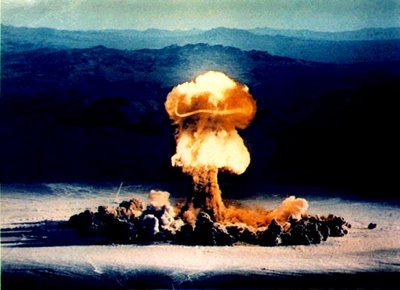San Francisco - The Bush Administration is objecting to a groundbreaking treaty that set up a nuclear weapon-free zone in Central Asia.

Go to Original
Five Former Soviet Republics Give Up Nukes
By Aaron Glantz
OneWorld US
Wednesday 13 September 2006
San Francisco - The Bush Administration is objecting to a groundbreaking treaty that set up a nuclear weapon-free zone in Central Asia.
Under the treaty signed Friday, Kazakhstan, Kyrgyzstan, Tajikistan, Uzbekistan, and Turkmenistan committed themselves not to produce, buy, or allow the deployment of nuclear weapons on their soil.
But the United States, along with Britain and France, refused to attend the signing ceremony in the Kazakh capital, Almaty, citing a 1992 treaty that Russia signed with four of the five nations that Moscow claims could allow missiles to be deployed in the region.
In a fresh statement issued Monday, the US Embassy in Kazakhstan warned that "other international treaties could take precedence over the provisions of this treaty, and thus obviate the central objective of creating a zone free of nuclear weapons."
Arms control groups believe the Bush administration is being disingenuous.
"The reason that many of us suspect the US is opposed to this is more fundamental," the independent Arms Control Association's Daryl G. Kimball told OneWorld. "This is a very strategic region. The US is reticent to give up the option of deploying nuclear weapons in this region in the future."
In May, the journal Foreign Policy named Manas airbase in Kyrgyzstan one of the six most important US military bases in the world. The base was originally established as a hub for multinational operations following the September 11th attacks five years ago.
"In addition to its proximity to Afghanistan," the Foreign Policy article stated, "Manas is located near the immense energy reserves of the Caspian Basin, as well as the Russian and Chinese frontiers."
According to Jackie Cabasso, who heads up the Western States Legal Foundation in Oakland, California, "the United states had drawn up a battle plan for the potential use of nuclear weapons in Iraq and the Untied States has been involved in planning potential nuclear use scenarios for Iran."
"The United States is now involved in a massive program to overhaul its nuclear arsenal," she added. "In fact they're working to replace every nuclear warhead and all of the existing delivery systems in the arsenal to ensure prompt precision global strike capabilities. So the United States is openly using the threatened use of nuclear weapons around the world."
David Krieger of the Nuclear Age Peace Foundation added that members of the Bush administration "like to talk about expanding the use of nuclear weapons and talk about the 'preventive use' of nuclear weapons [but seem] to be negative toward a group of countries trying to create a ban on nuclear weapons within their territory."
By contrast, arms control experts argue, former Soviet republics in Central Asia have every reason to want to rid themselves of their nuclear legacy.
During the Cold War, the Soviet Union used a facility at Semipalatinsk in Kazakhstan to test new nuclear weapons. Between 1949 and 1989 almost 500 nuclear explosions were carried out there, equaling the explosive power of 20,000 Hiroshima bombs.
According to the country's president, Nursultan Nazarbayev, those explosions caused irreparable damage to the health of more than 1.5 million Kazakh citizens, blighted lives, and rendered vast stretches of land useless for generations.
Western States Legal Foundation's Cabasso told OneWorld the central Asian nation has one of the strongest anti-nuclear movements in the world.
She described a visit to Kazakhstan, made in 1990 shortly after the fall of the Soviet Union.
"It was amazing," Cabasso said. "When we flew from Moscow to the capital Almaty, there were people on the run-way in traditional costumes holding signs like 'Let the Generals Build Their Summer Houses on the Nuclear Test Site.'"
Cabasso said the movement for a nuclear free Central Asia began with a poet and member of the Soviet Duma named Olzhas Suleimenov. In 1989, after discovering that some of the underground nuclear tests had leaked radiation into the atmosphere, he went on television and called for a mass meeting at the writers' union hall. Over 5,000 people showed up the next day.
"They organized on a massive scale," Cabasso said. "Ten thousand copper miners went out on strike, there were billboards at the airport. Imagine if you had anti-nuclear demonstrations going on during half-time at the Super Bowl. They were calling for a peaceful non-nuclear transition to the 21st century back in 1990 and now they have completed that transition in a way."
The treaty between Kazakhstan, Kyrgyzstan, Tajikistan, Uzbekistan, and Turkmenistan created the first nuclear-weapons free zone in the Northern Hemisphere. Countries in Latin America and the Caribbean, the South Pacific, Southeast Asia, and Africa have already pledged to remain nuclear free.
--------------------------------------------------------------------------------
Related Links: >>>CONT
Link Here




0 Comments:
Post a Comment
<< Home